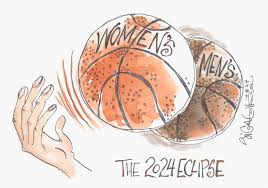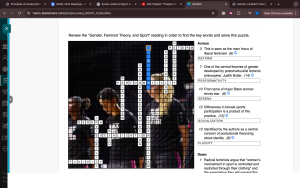1
Section One: The Fundamentals
A) What do we know about sport? What are common assumptions we make about sport and society?
| Sports can be an amazing avenue for young people to connect with others and develop their sense of self through the diverse experiences and opportunities that sports can offer. However, there is no guarantee that the development will be positive. Many sport-related spaces, such as locker rooms, can be places where misogynistic, homophobic, and other problematic attitudes are accepted and even embraced. When people are exposed to this rhetoric when they are younger and more impressionable, there are greater chances of them going on to embrace or accept such perspectives in the future. This presence of polarizing beliefs is also evident in conversations around trans athletes, further highlighting how although sports can build positive character traits ,it is equally as capable of generating negativity and vitriol towards already marginalized groups. Moreover, sports can also foster negative characteristics or characteristics that can manifest negatively in other areas of life such as excessive competitiveness or aggressiveness, with instances of failure leading to poor self-esteem and confidence. |
Exercise 3: Notebook prompt
What are some other metanarratives about sport that you are familiar with? Find an image or video clip or draw something yourself that captures this idea…
So what? Why does any of this matter? Does it matter? As something we grow up with – live with – play through – we don’t often interrogate the meanings of sport, and perhaps we don’t want to.
But being aware of these assumptions and metanarratives is especially important, I would argue, because of the centrality of sport to our everyday lives, the role that sport plays in shaping our childhood and worldviews and….. [finish that thought]
| https://www.youtube.com/watch?v=G74ZHWcsbgc
This is a famous youtube clip of a bowler that went viral years back for his funny quote after getting a strike “who do you think you are, I am”. Although this clip is hilarious, I think it comedically reflects many metanarratives about sports such as the pursuit of excellence with his positioning of himself as superior, as well as heroism and glory reflected in his intensity and celebration upon success. The fact that this event was televised and then received virality also reflects the metanarrative of entertainment and spectacle. But being aware of these assumptions and metanarratives is especially important, I would argue, because of the centrality of sport to our everyday lives, the role that sport plays in shaping our childhood and worldviews and interpersonal relations, thus providing a lense to navigate these complex systems and interactions that shape and influence a given activity. |
B) What is social justice?
Exercise 4: Padlet Prompt
Think back to the last section and try to look at some of the ideas we discussed differently. How might sport and social justice actually co-exist?
Record any images, video clips, or gifs you added to the padlet and identify a point of intersection between sport and social justice (can be an issue or a barrier or a debate or something you would like to explore in more depth in this course) . Screenshot or paste in your response below.
| When reflecting on how social justice relates to access and opportunity within sports, it becomes glaringly evident that the primary barrier is financial. Not only is membership to a sports team expensive, but equipment costs, the travel required among competitive participants and the demands on time and other resources make participation in sports increasingly inaccessible for the most marginal and disadvantaged populations in society. This is particularly true for those with diminished agency and ability, such as children or those with certain disabilities who may require additional assistance accessing their sport, equipment, and aid attending practice or games, further indicating how this issue becomes amplified among intersectional identities. This extends beyond just the playing of the sport and encompasses viewership as well. Many sports are on a pay-per-view basis or are only streamed on certain channels, which reduces their accessibility. This is something that the NBA’s Portland Trail Blazers are attempting to combat by giving away TV antennas for those who are unable to view the game otherwise. Many teams have also begun to include family packages which include admission, food, drinks, and parking for a realistic/more reasonable price which promotes its accessibility. |
C) Social Justice Reading
(note: this activity is optional!)
D) KINESIOLOGY AND SOCIAL JUSTICE
Exercise 5:
Exercise 6:
What are the implications of bodies-at-risk discourse and the refusal to understand the health gap from a social justice perspective, according to the authors of this article?
| The bodies-at-risk discourse has several implications, particularly that these bodies are not sufficient and require fixing. These groups are consequently then blamed for their failure to comply with health or physicality norms, thus increasingly becoming perceived as a social problem. This can be attributed in large to the rise of healthism which places the emphasis on personal responsibility and individual choice, moralizing health practices in a manner which obscures the social inequalities that influence the construction of bodies-at-risk, blaming these populations for failing to self-manage their health. This discourse maintains whiteness as the norm, containing either overt or subtle messages promoting hegemonic values and ideologies. As such it becomes necessary to recognize the importance of examining these discourses from a social justice perspective, otherwise marginalized groups will continue to face adverse health outcomes with no hope for change and these systems will continue to function in manners which privilege some populations over others. |
Section Two: Sport Feminism
Exercise 7: Notebook Prompt
What is feminism? What does it mean to you? Choose one of the images below and explain how it captures your understanding of feminism (or find one that does speak to you and paste this into your pressbook with an explanation of why it matters to you.

Although there are several different branches and schools of thought within feminism, I find feminism in general to be an understanding of the existence of the patriarchy; a gendered hierarchy within society that works to privilege men in a variety of different ways, and has infiltrated all areas of life. As a result men hold more power and influence within private and public spheres, with a women’s marginalization compounding along intersectional lines. Most feminist theories reject the patriarchy and working to combat and counteract its impacts on society. To me feminism is almost a way of going about life. It is something that I carry with me in every conversation and interaction. It is a conscious effort to counteract my own internalised misogyny and patriarchal ideals that have come to be normalised to a great extent in society. It is a rejection of beauty and fashion trends, fad diets, and other social practices which ingrain gendered expectations and unattainable standards. Most importantly, feminism to me is the acceptance and uplifting of all individuals, something that I feel is captured within this image. I am not sure of the exact event this image is from but it depicts men and women alike from all walks and stages of life gathered together in the common belief that women are deserving of equal and fair treatment. It provides a powerful representation and reminder of what has been and still is possible through the power of collective action and resistance. |
Exercise 8: Notes Prompt (optional)
NB: Cornell notes is a great resource that teaches effective notetaking. Unfortunately, our system can’t save notes taken in the H5P app, so this is fully optional.
Exercise 9: Crossword Activity
Exercise 10: Padlet Prompt
| Liberal Feminism: In relation to sport, it believes that they provide a positive experience to which women ought to have equal access, with a focus on addressing the socialisation practices and discriminations that limit their opportunities. Consequently, this perspective views the differences in female sport participation as the result of socialization practices, unequal access to facilities or resources, and their lack of presence in decision-making roles. This perspective has been critiqued for its generalizations of women’s experiences, neglecting the influence of intersectional oppressions in shaping people’s experiences
Marxist/Socialist Feminism: In relation to sport, it believes that gender inequalities are derived from capitalism, class, and economic exploitation, as well as the sexual division of labour. This is evident in womens supporting roles at sporting events (eg; providing refreshments) which reflects their roles in paid work and domestic labor impacting their capacity for sport. It also recognized that sport is a tool often used to construct masculinity which can both advantaged and disadvantaged men through their adherence to narrow definitions of masculinity. Black Feminism and Sport: In relation to sport, it suggests that white feminist theories exclude and make invisible the experiences of black women, arguing that sites of oppression differ. They have not only failed to address the marginalization of black women but have failed to seriously interrogate their own whiteness. They acknowledge the role of intersectionality of race, gender, and class in the context of sport, influencing who has access and to what degree. Queer Theory: In relation to sport, it focuses on gender and sexuality, deconstructing sexual identity and heteronormative discourses and beyond lesbian/gay politics of identity to one of difference, resistance, and challenge From: Scraton, Sheila, and Anne Flintoff. “Gender, Feminist Theory, and Sport.” In A Companion to Sport, 96–111. Oxford, UK: John Wiley & Sons, Ltd, 2013. https://doi.org/10.1002/9781118325261.ch5. |

|
|


